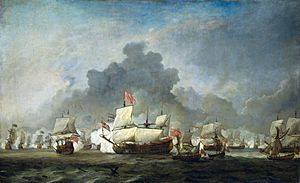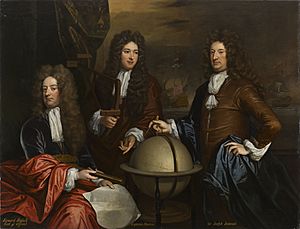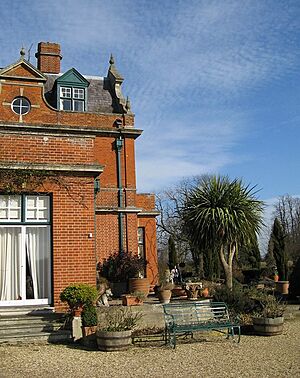Edward Russell, 1st Earl of Orford facts for kids
Quick facts for kids
The Earl of Orford
|
|
|---|---|

Admiral Edward Russell, 1st Earl of Orford, Thomas Gibson
|
|
| First Lord of the Admiralty | |
| In office 1694 to 1699 – 1709 to 1710 – 1714 to 1717 |
|
| Lord Lieutenant of Cambridgeshire | |
| In office 1715–1727 |
|
| Member of Parliament for Cambridgeshire |
|
| In office November 1695 – May 1697 |
|
| Member of Parliament for Portsmouth |
|
| In office March 1690 – October 1695 |
|
| Treasurer of the Navy | |
| In office 1689–1699 |
|
| Member of Parliament for Launceston |
|
| In office January 1689 – February 1689 |
|
| Personal details | |
| Born | 10 February 1657 Chiswick, London, England |
| Died | 26 November 1727 (aged 70) Covent Garden, London, England |
| Resting place | St Michael's, Chenies |
| Political party | Whig |
| Spouse | Lady Margaret Russell |
| Alma mater | St John's College, Cambridge |
| Occupation | Sailor and politician |
| Military service | |
| Allegiance | |
| Branch/service | |
| Years of service | 1666–1717 |
| Rank | Admiral of the Fleet |
| Commands | Commander-in-Chief, Channel Fleet Phoenix; Reserve; Defiance; Swiftsure; Newcastle |
| Battles/wars | Third Anglo-Dutch War Battle of Solebay Nine Years' War Battles of Barfleur and La Hogue |
Admiral of the Fleet Edward Russell, 1st Earl of Orford (1653 – 26 November 1727) was an important officer in the Royal Navy and a politician. He started his naval career as a junior officer. He fought in the Battle of Solebay during the Third Anglo-Dutch War. Later, he commanded ships in the Mediterranean Sea against pirates.
Russell was one of the "Immortal Seven." This was a group of English noblemen. They invited Prince William of Orange to become king. This led to the Glorious Revolution. Russell helped plan William's invasion of England. He also supported the war in Ireland with naval forces. He became Commander-in-Chief of the Anglo-Dutch fleet. He led them to victory against the French at the Battle of Barfleur and destroyed many French ships.
He served as First Lord of the Admiralty three times. This was a very high position in the navy. He also served as a MP for different areas. These included Launceston, Portsmouth, and Cambridgeshire.
Contents

Edward Russell was born in 1657. His father was the Hon. Edward Russell. His family was connected to the Earl of Bedford. He briefly studied at St John's College, Cambridge. Then, he joined the Royal Navy in 1666.
He became a lieutenant in 1671. He served on ships like HMS Advice and HMS Rupert. In May 1672, he fought in the Battle of Solebay. This battle was off the Suffolk coast. The Dutch fleet, led by Admiral Michiel de Ruyter, attacked the combined British and French fleets.
Russell was promoted to captain in June 1672. He commanded several ships. These included HMS Phoenix, HMS Reserve, HMS Defiance, HMS Swiftsure, and HMS Newcastle. He sailed in the Mediterranean Sea. He helped fight against the Barbary pirates. In 1683, he stopped working for the navy. This was because his family had problems with the King.
A Key Player in Big Changes
Russell was part of the "Immortal Seven." This group of English noblemen asked William, Prince of Orange, to take the throne from King James II. This happened in June 1688. Russell was in the Netherlands. He worked as Prince William's secretary. He helped plan William's invasion of England. This event is known as the Glorious Revolution of November 1688.
In 1689, Russell became a Whig Member of Parliament for Launceston. He was also made Treasurer of the Navy. He was promoted to full admiral in May 1689. He took command in the Channel. He helped block French ships.
Russell lived at Chippenham Park in Cambridgeshire from 1689. He lived there until he died. He made many changes to the manor house. He also expanded the park.
Russell became an MP for Portsmouth in 1690. He helped transport Maria Anna of Neuburg, who would marry the King of Spain. After a difficult battle at Beachy Head in July 1690, Admiral Torrington lost favor. Russell was promoted to Admiral of the Fleet. He became Commander-in-Chief of the Navy in December 1690. He provided naval support for the Williamite War in Ireland. This war ended in October 1691.

In 1690, Russell blamed the Dutch for not blocking France properly. He had to step down from his role in January 1691. But he soon returned as Commander-in-Chief. He led the Anglo-Dutch fleet. They fought the French fleet at the Battle of Barfleur in May 1692. This was during the Nine Years' War. Russell's fleet fought bravely. They damaged many French ships. Later, Russell destroyed more French ships in a night attack at the Battle of La Hogue.
After some disagreements, Russell resigned as Commander-in-Chief in December 1692. Other admirals took over. But after a problem at the Battle of Lagos in June 1693, Russell was asked to command the fleet again in November 1693.
Russell became First Lord of the Admiralty in May 1694. He took a fleet to the Mediterranean. He was the first English naval commander to stay there for the winter. He was elected MP for Cambridgeshire in 1695. In 1697, he was given the titles Baron Shingay, Viscount Barfleur, and Earl of Orford. He faced some questions about how he managed navy funds. However, these issues were resolved. He left his navy and political roles in May 1699. He also had Orford House built in Ugley in 1700.
Russell returned as First Lord in November 1709. He left this role in October 1710. He was appointed First Lord for a third time in October 1714. He also became Lord Lieutenant of Cambridgeshire in 1715. He left his posts again in April 1717. He passed away in Covent Garden, London, on 26 November 1727. He was buried at St Michael's Church in Chenies.
Family
In November 1691, Edward Russell married his cousin, Lady Margaret Russell. She was the youngest daughter of the 5th Earl of Bedford. They did not have any children. They lived at 43 King Street, Covent Garden, until Russell's death.



